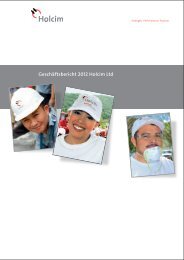Transocean Proxy Statement and 2010 Annual Report
Transocean Proxy Statement and 2010 Annual Report
Transocean Proxy Statement and 2010 Annual Report
You also want an ePaper? Increase the reach of your titles
YUMPU automatically turns print PDFs into web optimized ePapers that Google loves.
TRANSOCEAN LTD. AND SUBSIDIARIES<br />
NOTES TO CONSOLIDATED FINANCIAL STATEMENTS — Continued<br />
Contract drilling intangible revenues—In connection with the Merger, we acquired drilling contracts for future contract drilling<br />
services of GlobalSantaFe. The terms of these contracts include fixed dayrates that were above or below the market dayrates available for<br />
similar contracts as of the date of the Merger. We recognized the fair value adjustments as contract intangible assets <strong>and</strong> liabilities,<br />
recorded in other assets <strong>and</strong> other long-term liabilities, respectively. We amortize the resulting contract drilling intangible revenues on a<br />
straight-line basis over the respective contract period. During the years ended December 31, <strong>2010</strong>, 2009 <strong>and</strong> 2008, we recognized<br />
contract intangible revenues of $98 million, $281 million <strong>and</strong> $690 million, respectively. See Note 10—Goodwill <strong>and</strong> Other Intangible<br />
Assets.<br />
Other revenues—Our other revenues represent those derived from drilling management services, integrated services, oil <strong>and</strong><br />
gas properties, <strong>and</strong> customer reimbursable revenues. For fixed-price contracts associated with our drilling management services, we<br />
recognize revenues <strong>and</strong> expenses upon well completion <strong>and</strong> customer acceptance, <strong>and</strong> we recognize loss provisions on contracts in<br />
progress when losses are anticipated. We refer to integrated services as those services we provide through contractors <strong>and</strong> our<br />
employees under certain contracts that include well <strong>and</strong> logistics services in addition to our normal drilling services. We consider customer<br />
reimbursable revenues to be billings to our customers for reimbursement of certain equipment, materials <strong>and</strong> supplies, third-party services,<br />
employee bonuses <strong>and</strong> other expenses that we recognize in operating <strong>and</strong> maintenance expense, the result of which has little or no effect<br />
on operating income.<br />
Share-based compensation—For time-based awards, we recognize compensation expense on a straight-line basis through the<br />
date the employee is no longer required to provide service to earn the award (the “service period”). For market-based awards that vest at<br />
the end of the service period, we recognize compensation expense on a straight-line basis through the end of the service period. For<br />
performance-based awards with graded vesting conditions, we recognize compensation expense on a straight-line basis over the service<br />
period for each separately vesting portion of the award as if the award was, in substance, multiple awards. Share-based compensation<br />
expense is recognized, net of a forfeiture rate, estimated at the time of grant based on historical experience <strong>and</strong> adjusted, if necessary, in<br />
subsequent periods based on actual forfeitures.<br />
To measure the fair values of time-based restricted shares <strong>and</strong> deferred units granted or modified, we use the market price of<br />
our shares on the grant date or modification date. To measure the fair values of stock options <strong>and</strong> stock appreciation rights (“SARs”)<br />
granted or modified, we use the Black-Scholes-Merton option-pricing model <strong>and</strong> apply assumptions for the expected life, risk-free interest<br />
rate, dividend yield <strong>and</strong> expected volatility. The expected life is based on historical information of past employee behavior regarding<br />
exercises <strong>and</strong> forfeitures of options. The risk-free interest rate is based upon the published U.S. Treasury yield curve in effect at the time<br />
of grant or modification for instruments with a similar life. The dividend yield is based on our history <strong>and</strong> expectation of dividend payouts.<br />
The expected volatility is based on a blended rate with an equal weighting of the (a) historical volatility based on historical data for an<br />
amount of time approximately equal to the expected life <strong>and</strong> (b) implied volatility derived from our at-the-money long-dated call options. To<br />
measure the fair values of market-based deferred units granted or modified, we use a Monte Carlo simulation model <strong>and</strong>, in addition to the<br />
assumptions applied for the Black-Scholes-Merton option-pricing model, we apply assumptions using a risk neutral model <strong>and</strong> an average<br />
price at the performance start date. The risk neutral model assumes that all peer group stocks grow at the risk-free rate. The average<br />
price at the performance start date is based on the average stock price for the preceding 30 trading days.<br />
We recognize share-based compensation expense in the same financial statement line item as cash compensation paid to the<br />
respective employees. Tax deduction benefits for awards in excess of recognized compensation costs are reported as a financing cash<br />
flow. Share-based compensation expense was $102 million, $81 million <strong>and</strong> $64 million in the years ended December 31, <strong>2010</strong>, 2009 <strong>and</strong><br />
2008, respectively. Income tax benefit on share-based compensation expense was $10 million, $8 million, <strong>and</strong> $8 million in the years<br />
ended December 31, <strong>2010</strong>, 2009 <strong>and</strong> 2008, respectively. See Note 17—Share-Based Compensation Plans.<br />
Pension <strong>and</strong> other postretirement benefits—We use a measurement date of January 1 for determining net periodic benefit<br />
costs <strong>and</strong> December 31 for determining benefit obligations <strong>and</strong> the fair value of plan assets. We determine our net periodic benefit costs<br />
based on a market-related valuation of assets that reduces year-to-year volatility by recognizing investment gains or losses over a<br />
five-year period from the year in which they occur. Investment gains or losses for this purpose are measured as the difference between<br />
the expected return calculated using the market-related value of assets <strong>and</strong> the actual return based on the market-related value of assets.<br />
The obligations <strong>and</strong> related costs for our defined benefit pension <strong>and</strong> other postretirement benefit plans, retiree life insurance<br />
<strong>and</strong> medical benefits, are actuarially determined by applying assumptions, including long-term rate of return on plan assets, discount rates,<br />
compensation increases, employee turnover rates <strong>and</strong> health care cost trend rates. The two most critical assumptions are the long-term<br />
rate of return on plan assets <strong>and</strong> the discount rate.<br />
For the long-term rate of return, we develop our assumptions regarding the expected rate of return on plan assets based on<br />
historical experience <strong>and</strong> projected long-term investment returns, which are weighted to consider each plan’s target asset allocation. For<br />
the discount rate, we base our assumptions on a yield curve approach using Aa-rated corporate bonds <strong>and</strong> the expected timing of future<br />
benefit payments. For the projected compensation trend rate, we consider short-term <strong>and</strong> long-term compensation expectations for<br />
participants, including salary increases <strong>and</strong> performance bonus payments. For the health care cost trend rate for other postretirement<br />
benefits, we establish our assumptions for health care cost trends, applying an initial trend rate that reflects both our recent historical<br />
experience <strong>and</strong> broader national statistics with an ultimate trend rate that assumes that the portion of gross domestic product devoted to<br />
health care eventually becomes constant.<br />
AR-80

















